Being among nature and enjoying the landscape has always been part of my life. I grew up in Corby in Northamptonshire, which is surrounded by beautiful countryside, and as child I would spend as much time as possible outdoors.
I didn’t pick up a camera until I was in my mid-20s and it soon became an extension to my outdoor excursions. I have always been creative, painting the landscape when I was younger, so landscape photography came as second nature. Being outside is integral to my wellbeing, and capturing it via the medium of photography often feels like the cherry on top, just another way of enjoying the beauty.
Photography has taught me to see the beauty in everything, from large vistas to the smallest detail. There is joy to be found in the quiet tranquillity of the morning, my favourite time to be outside, and sharing that stillness with others.
- How to be an ethical photographer
- Stunning photography reveals just how clever sheep dogs are
- Britain's best locations for landscape photography

Duality, Sutton Park, Birmingham
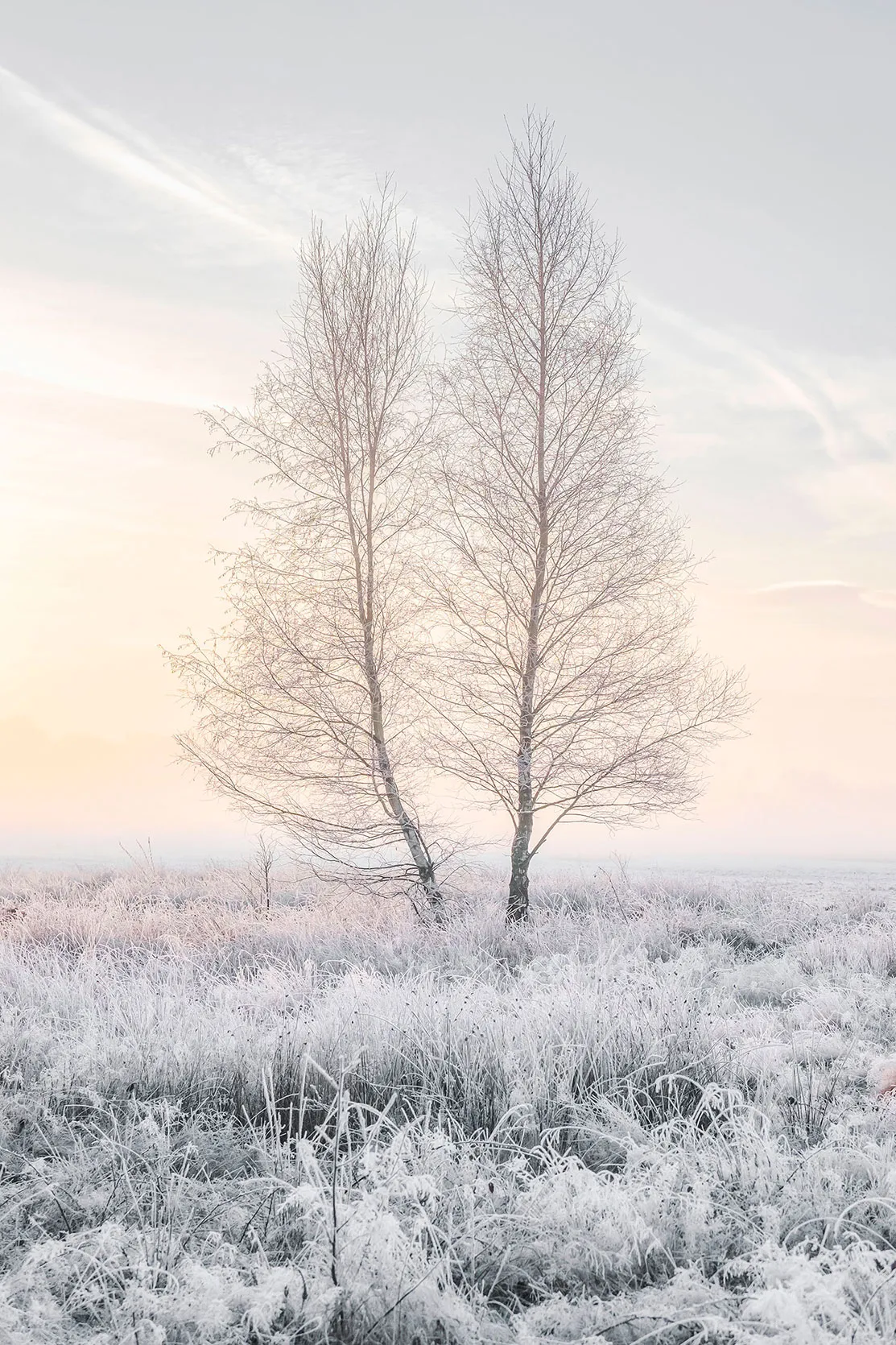
So often, the first few photos I capture when I arrive at a location turn out to be my favourites and this is a prime example. The mist was drifting across the clearing at Sutton Park, ensuring the two birch trees stand out from the frosty grass, seemingly existing in isolation.
Camera and settings: Fujifilm X-T2 + XF50–140mm F2.8 R LM OIS WR @ 50mm telephoto lens. f/6.4; 1/150; ISO 320
Bewdley’s Poppies, Worcestershire

Arriving at this field early on a June morning, I was in awe – this is one day I won’t forget. Mist drifting through the valley and a sea of red poppies. The end result was almost surreal and resonated with people far and wide. I doubt I’ll ever witness such a scene again.
Camera and settings: Canon 5D Mk IV + EF70-200mm f/2.8L IS III USM @ 80mm telephoto lens. f/11; 1/80; ISO 100
Bluebells of Clent Hills, Worcestershire
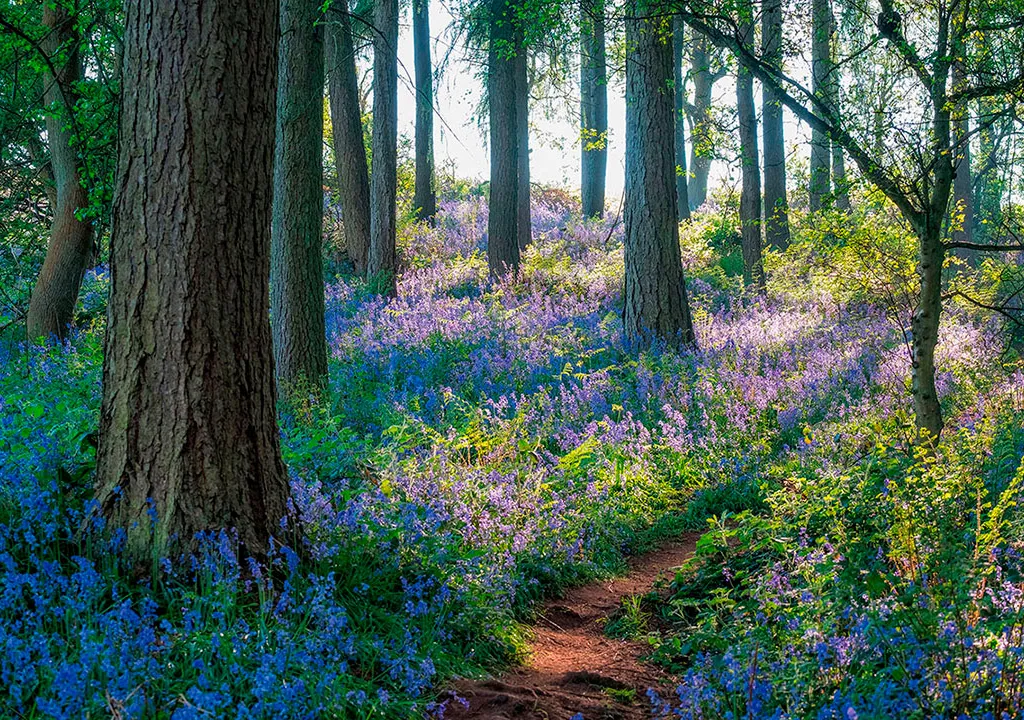
What could be more quintessentially English than a woodland full of bluebells? Clent is one of my favourite local places for landscape photography, especially in spring. I loved the morning light finally breaking through the woodland and backlighting the myriad of bluebells as the pathway snaked upwards past stalwart trees.
Camera and settings: Fujifilm X-T2 + XF50–140mm F2.8 R LM OIS WR @ 50mm telephoto lens. f/6.4; 1/40; ISO 500
Elgol, Isle of Skye

I had just spent a month in the Outer Hebrides and decided to pop to Skye on my way home. Although it was early March, the conditions were calm. I stood in the same place, taking in the grandeur of the Cuillin range as the sun set. It was a magical evening.
Camera and settings: Canon R5 + Zeiss Milvus 25mm @ 25mm wide-angle lens. f/13; 1 sec; ISO 100
In Flight Over Derwentwater, Lake District

I can be very harsh about my own photography, but this image, taken nearly eight years ago, remains one of those I will always treasure. One of the first mornings I experienced such magical conditions and everything seemed to come together.
Camera and settings: Canon 5D Mk III + EF24–70mm f/2.8L II USM @ 70mm lens. f/11; 1/200; ISO 320
Achmore Rainbow, Isle of Lewis
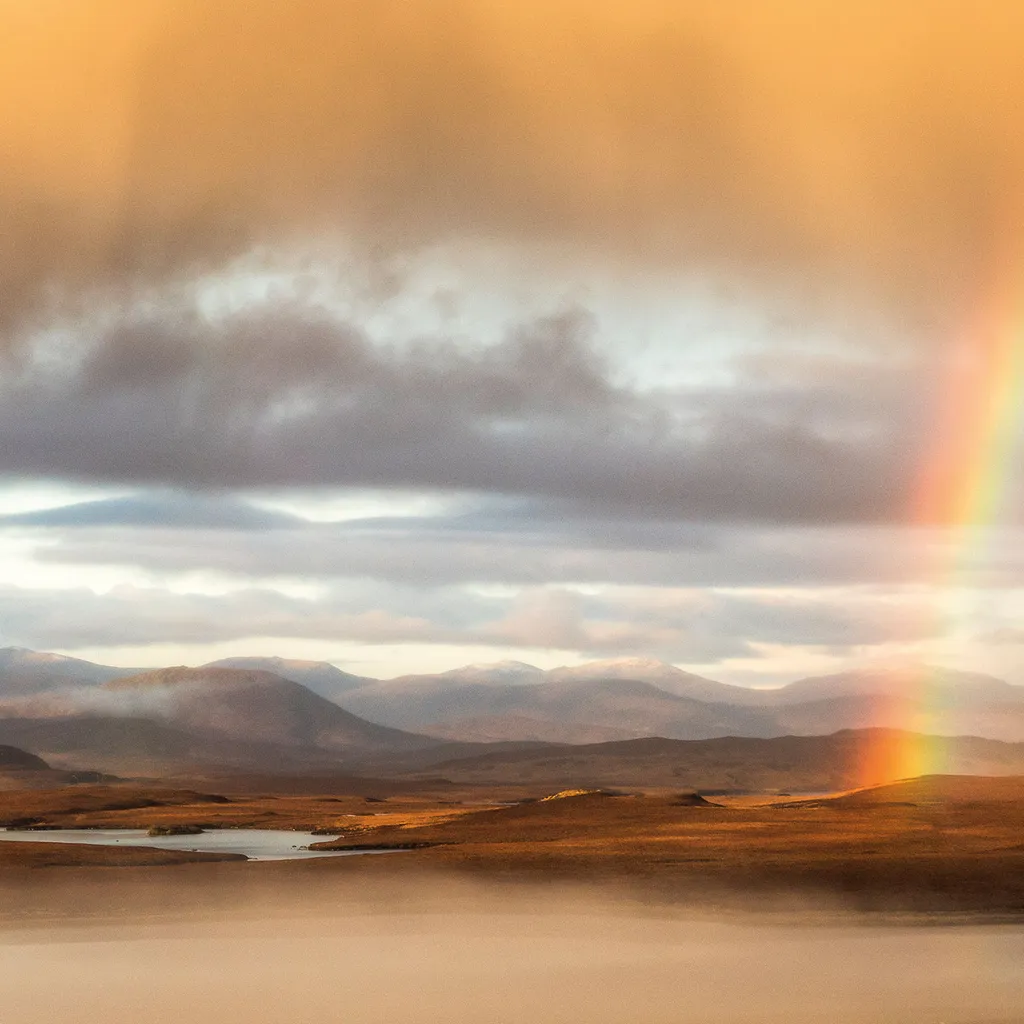
One of those mornings I was driving without aim when this amazing rainbow appeared over the North Harris hills. Sunrise was happening, illuminating the clouds, and catching on the mist in the loch. The rainbow stuck around for a good 20 minutes as I ran up and down the road, jumping for joy.
Camera and settings: Olympus E-M5 MarkII + OLYMPUS M.40–150mm F2.8 @ 40mm telephoto lens. f/14; 1/60; ISO 200
Heather Sunrise at Millstone Edge, Peak District
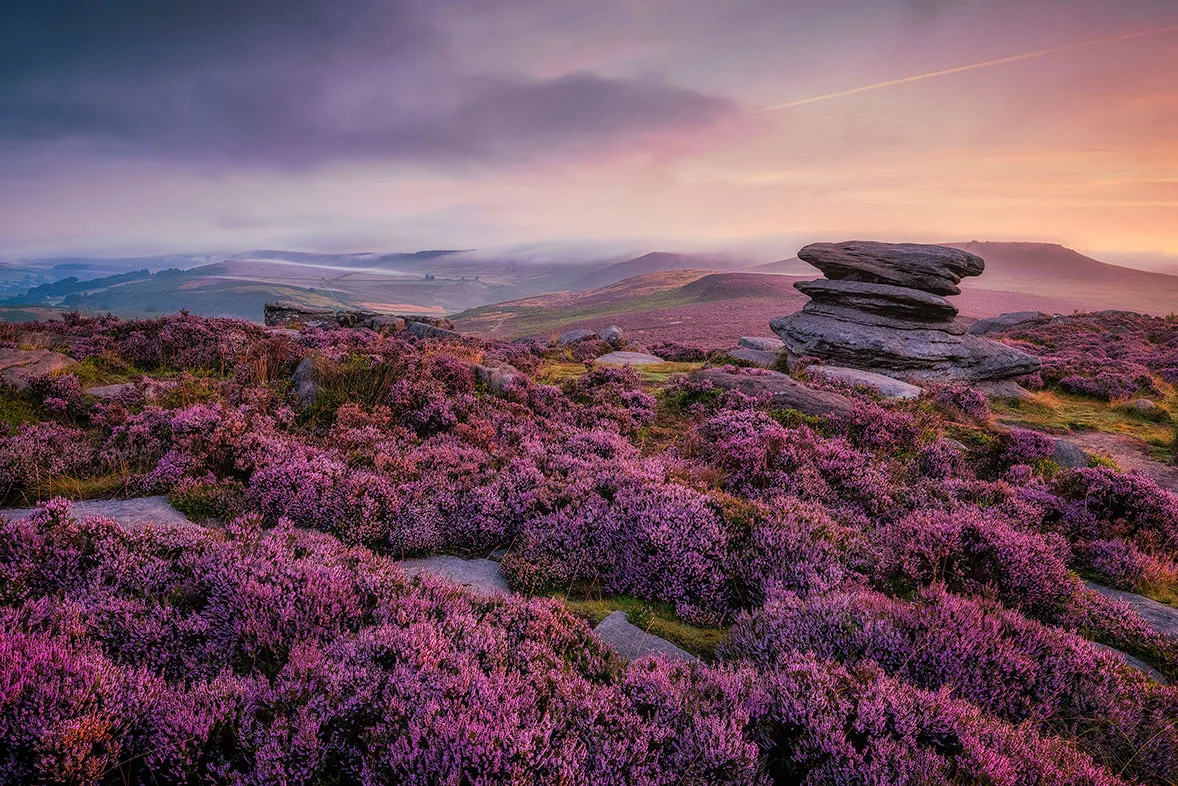
Although it’s tough, especially during summer, I try to get to a location an hour before sunrise. On this morning, low cloud drifted across the edges of the Peak District, catching the colour of the rising sun. Soon the cloud had consumed all the light, so this was my best shot of the day.
Camera settings: Canon R5 + EF16–35mm f/2.8L III USM @ 21mm wide-angle lens. f/11; 4/5; ISO 100
Heather at Stanton Moor, Peak District
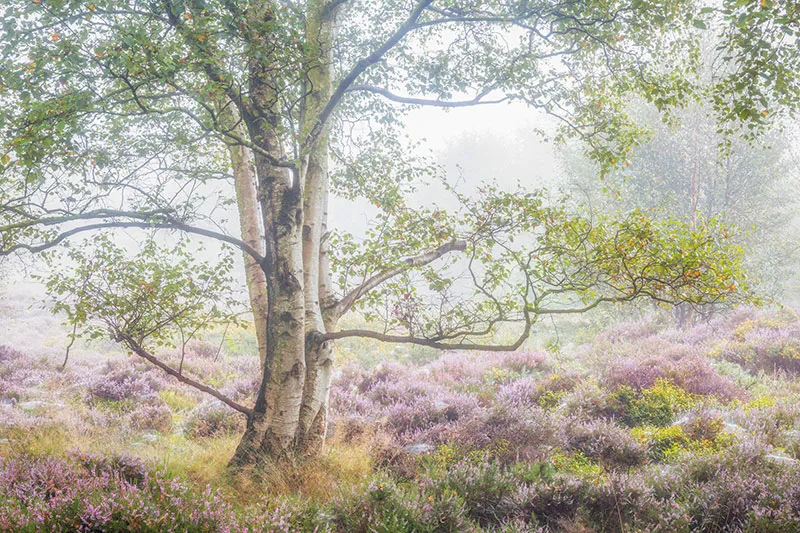
This photo was taken the first time I discovered Stanton Moor. I was full of excitement when I happened across this scene. In late August, the Peak District is covered in heather and up on Stanton Moor, the low cloud can create atmospheric conditions among the birch trees.
Camera settings: Canon 5D Mk III + EF24–70mm f/2.8L II USM @ 61mm zoom lens. f/13; 1/8; ISO 100
Top five photography tips
1 Sunrise and Sunset
If you find that your images are a little lacklustre, try getting up earlier or staying out later. Often the best time for landscape photography is at either end of the day. At sunrise, there is always a possibility of ethereal conditions, as well as a light quality that isn’t possible at any other time. The low light at sunset also lends itself to gorgeous photos.
2 Return to Locations
One of the greatest joys of landscape photography is that the light is never the same twice. I love returning to locations time and again. I don’t think you can get the best out of a location on your first visit, and I like to take note of compositions that might work at a different time of day or a different season.
3 Think outside the wide angle
When I first got into landscape photography, a wide-angle lens was permanently attached to my camera. In hindsight, I would say that mastering the art of shooting wide-angle is one of the toughest tasks. Some of my favourite landscape images have been shot with telephoto lenses. Having the reach of a longer lens enables me to go deep into a composition and explore the smaller details that could otherwise have been missed if I was shooting with a wider lens. This kind of landscape photography can be difficult to master, but it offers up the opportunity to capture a scene from unexplored angles.
4 Breaking the rules
Rules, such as the rule of thirds, are there to be broken, particularly if you’re photographing reflections. In this image (above right), it makes more sense – and it’s more visually pleasing – to position the horizon in the middle of the image so you can maximise the impact of the reflection. This can be especially effective when capturing a body of water, especially in calm conditions.
5 Consider filters
Filters can be useful to enhance creativity. Graduated filters can ensure an even exposure through the image by darkening the sky so there are no blown highlights, and neutral density (ND) filters can extend the shutter speed to create a long exposure, which can be useful if you’re shooting fast-moving clouds or the sea. Experiment with different types of ND filters (such as a six-stop or a 10-stop).
The technical details explained
F-stop
This is the aperture of the lens: f/2.8 is a wide aperture allowing in more light (and a shallow depth of field), while f/16 is narrow, allowing in less light (and a large depth of field).
Shutter speed
This is the length of time the shutter is open, measured in fractions of a second. For example, 1/4 means a quarter of a second and is a long shutter speed, while 1/200 means 200th of a second. With a long shutter speed, moving objects will appear blurred.
ISO
This refers to the sensitivity of the camera’s sensor and controls exposure, along with the f/stop and shutter speed. ISO originally referred to the light sensitivity of film – its “light gathering” ability. A low value, such as ISO 100, is best for a sunny outdoor shoot; at night or indoors with dim lighting, use an ISO of 1600 or higher.
